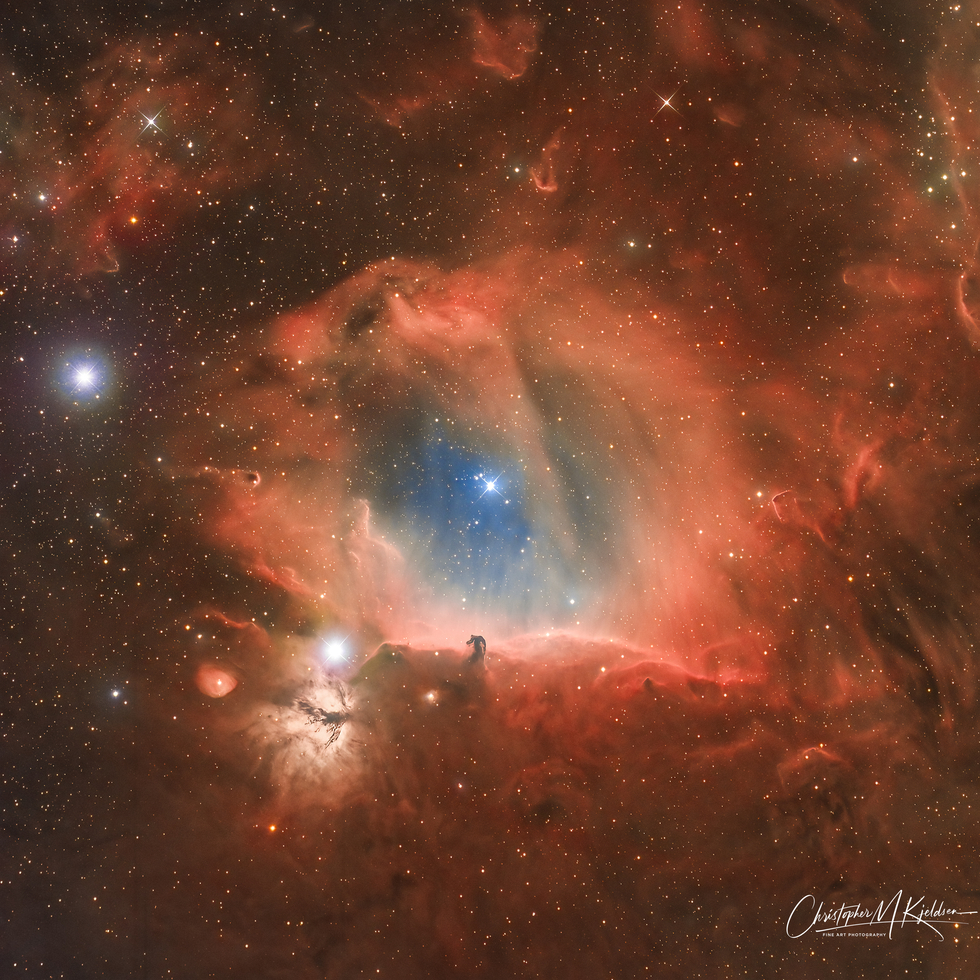Horsehead Area (Data from Orion Area Widefield)
Horsehead Area (Data from Orion Area Widefield)
The Horsehead Nebula, B33, is the dark nebula in front of the bright red emission nebula IC 434.
The Horsehead Nebula (also known as Barnard 33) is a small dark nebula in the constellation Orion. The nebula is located just to the south of Alnitak, the easternmost star of Orion's Belt, and is part of the much larger Orion molecular cloud complex. The nebula was first recorded in 1888 by Scottish astronomer Williamina Fleming on a photographic plate taken at the Harvard College Observatory.
The Horsehead Nebula is approximately 1,375 light-years from Earth. It is one of the most identifiable nebulae because of its resemblance to a horse's head. The darkness of the Horsehead is caused mostly by thick dust blocking the light of stars behind it. The lower part of the Horsehead's neck casts a shadow to the left. The visible dark nebula emerging from the gaseous complex is an active site of the formation of "low-mass" stars. Bright spots in the Horsehead Nebula's base are young stars just in the process of forming.
Along with the Orion Nebula, these nebulae near the Horsehead are part of a very large complex that is a stellar nursery where stars are forming out of the dust and gas. Located about 1,500 light years away, this complex is the closest star forming region to our own solar system.
Color images reveal a deep-red color that originates from ionized hydrogen gas predominantly behind the nebula (IC434) and caused by the nearby bright star Sigma Orionis. Magnetic fields channel the gases, leaving the nebula into streams, shown as foreground streaks against the background glow. A glowing strip of hydrogen gas marks the edge of the enormous cloud, and the densities of nearby stars are noticeably different on either side.
The Flame Nebula, NGC 2024, is to the lower left of Alnitak, the easternmost star in the three distinctive stars in the Hunter's belt of Orion, and the brightest star in this photo. The Flame Nebula, designated as NGC 2024 and Sh2-277, is an emission nebula in the constellation Orion. It is about 900 to 1,500 light-years away.
The bright star Alnitak, the easternmost star in the Belt of Orion, shines energetic ultraviolet light into the Flame and this knocks electrons away from the great clouds of hydrogen gas that reside there. Much of the glow results when the electrons and ionized hydrogen recombine. Additional dark gas and dust lies in front of the bright part of the nebula and this is what causes the dark network that appears in the center of the glowing gas. The Flame Nebula is part of the Orion molecular cloud complex, a star-forming region that includes the famous Horsehead Nebula
At the center of the Flame Nebula is a cluster of newly formed stars, 86% of which have circumstellar disks. X-ray observations by the Chandra X-ray Observatory show several hundred young stars, out of an estimated population of 800 stars. X-ray and infrared images indicate that the youngest stars are concentrated near the center of the cluster.
To the lower left of the Horsehead is the blue reflection nebula NGC 2023. NGC 2023 is an emission and reflection nebula in the equatorial constellation of Orion. It was discovered by the German-born astronomer William Herschel on 6 January 1785. This reflection nebula is one of the largest in the sky. It is located at 1,300 light years from the sun.
[AstroPix, Wiki]
The Horsehead Nebula (also known as Barnard 33) is a small dark nebula in the constellation Orion. The nebula is located just to the south of Alnitak, the easternmost star of Orion's Belt, and is part of the much larger Orion molecular cloud complex. The nebula was first recorded in 1888 by Scottish astronomer Williamina Fleming on a photographic plate taken at the Harvard College Observatory.
The Horsehead Nebula is approximately 1,375 light-years from Earth. It is one of the most identifiable nebulae because of its resemblance to a horse's head. The darkness of the Horsehead is caused mostly by thick dust blocking the light of stars behind it. The lower part of the Horsehead's neck casts a shadow to the left. The visible dark nebula emerging from the gaseous complex is an active site of the formation of "low-mass" stars. Bright spots in the Horsehead Nebula's base are young stars just in the process of forming.
Along with the Orion Nebula, these nebulae near the Horsehead are part of a very large complex that is a stellar nursery where stars are forming out of the dust and gas. Located about 1,500 light years away, this complex is the closest star forming region to our own solar system.
Color images reveal a deep-red color that originates from ionized hydrogen gas predominantly behind the nebula (IC434) and caused by the nearby bright star Sigma Orionis. Magnetic fields channel the gases, leaving the nebula into streams, shown as foreground streaks against the background glow. A glowing strip of hydrogen gas marks the edge of the enormous cloud, and the densities of nearby stars are noticeably different on either side.
The Flame Nebula, NGC 2024, is to the lower left of Alnitak, the easternmost star in the three distinctive stars in the Hunter's belt of Orion, and the brightest star in this photo. The Flame Nebula, designated as NGC 2024 and Sh2-277, is an emission nebula in the constellation Orion. It is about 900 to 1,500 light-years away.
The bright star Alnitak, the easternmost star in the Belt of Orion, shines energetic ultraviolet light into the Flame and this knocks electrons away from the great clouds of hydrogen gas that reside there. Much of the glow results when the electrons and ionized hydrogen recombine. Additional dark gas and dust lies in front of the bright part of the nebula and this is what causes the dark network that appears in the center of the glowing gas. The Flame Nebula is part of the Orion molecular cloud complex, a star-forming region that includes the famous Horsehead Nebula
At the center of the Flame Nebula is a cluster of newly formed stars, 86% of which have circumstellar disks. X-ray observations by the Chandra X-ray Observatory show several hundred young stars, out of an estimated population of 800 stars. X-ray and infrared images indicate that the youngest stars are concentrated near the center of the cluster.
To the lower left of the Horsehead is the blue reflection nebula NGC 2023. NGC 2023 is an emission and reflection nebula in the equatorial constellation of Orion. It was discovered by the German-born astronomer William Herschel on 6 January 1785. This reflection nebula is one of the largest in the sky. It is located at 1,300 light years from the sun.
[AstroPix, Wiki]
SPECIFICATIONS
Telescope
Takahashi FSQ-106EDX4
Camera
QHY 600M Pro
Location
IC Astronomy Observatory, Spain
Date of observation
November 4, 2022
Filters
Astrodon: Halpha, SII, OIII
Processing
• PixInsight • Lightroom • Photoshop
Comments
Here is the data set I used: OrionWidefield_SPA-3-CCDDISCONTINUED



